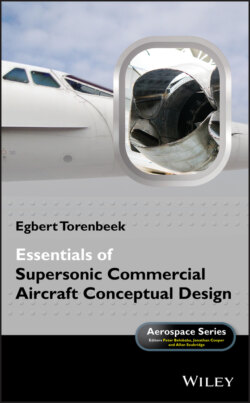Читать книгу Essentials of Supersonic Commercial Aircraft Conceptual Design - Egbert Torenbeek - Страница 12
1.2 SST Development Program
ОглавлениеThe efforts in the US to develop a supersonic airliner were preceded by a comprehensive program of supersonic military aircraft development. From the early 1950s the Air Force operated the Convair B‐58 Hustler Mach 2 bomber and the North American XB‐70 Valkyrie bomber/reconnaissance aircraft (Figure 1.2) was conceived during the late 1950s. The design specifications of the B‐70 were influenced by the opinion of military authorities that its high cruise speed should be approximately Mach 3 at 21,000 m altitude, since it was anticipated that the additional research for achieving the same flying qualities as for Mach 2 would be modest. However, aluminum alloys could not be used due to the strong kinetic heating effects of flying at Mach 3 and hence alternative structural materials such as stainless steel and titanium had to be incorporated. Test flying of the XB‐70 demonstrated that it had excellent aerodynamic qualities in supersonic flight as well as acceptable low‐speed characteristics. Although the B‐70 program was canceled for strategic reasons after three prototypes had been built and tested, arguments behind the development of a Mach 3 airliner were dominated by the experience gained during research of the XB‐70, and Boeing initiated a design study of an SST, which in 1952 resulted in the Boeing 2707‐300.
NACA's supersonic commercial air transport (SCAT) research program was initiated in 1957. Initially there was no government support for a CST development program. However, as soon as the European plans for producing the Concorde appeared to be taken seriously by the airlines, Pan Am wished to be “the first airline to go supersonic” and placed options to buy six aircraft. As one result of this challenge to the “free enterprise American industry”, the development of an SST prototype was addressed by President Kennedy in 1963 as a national objective. The FAA was designated to conduct a design competition between Boeing, Douglas, and Lockheed for a full‐scale pre‐production SST prototype program. Financial support by the USA government for the project was assured for a program whereby 90% of the funding came from the government and the remaining 10% from the industry. The government's investment would eventually be returned from the aircraft's proceeds of sale.
The American SST projects of the late 1960s and early 1970s aimed at carrying more than twice as many passengers as the Anglo‐French Concorde over considerably longer distances. Concorde's competitors initially chose an aggressive Mach 3 cruise regime for the US transport market, similar to the military supersonic cruising vehicles. NASA directed a competition between proposals generated by Boeing, Lockheed, and North American. Featuring a variable‐sweep wing and a predominantly titanium structure, the Boeing 2707‐200 Mach 2.7 airliner was clearly the most ambitious concept. Having the reputation of the most successful developer of jetliners, Boeing was considered to be capable of solving the foreseen problems of the 2707 program and became the winner of the competition. However, after millions of dollars were spent on advanced development it was concluded that problems with empty weight, load and balance, and aero‐elasticity were insurmountable.
A total design re‐think in 1969 resulted in the ultimate Boeing 2707‐300 design (Figure 1.3) which was based on application of a fairly highly loaded cropped delta wing in combination with a horizontal tailplane. Different from the generation of lift at low speeds with strong leading edge vortices at Concorde's highly‐swept wing, Boeing preferred the 2707 wing lift to be augmented by hinged flaps at the moderate leading edge sweep. The 2707 was an extremely challenging project that never reached the prototype stage as a consequence of the US government program termination in 1971. Among the principal factors that led to this decision were concerns about the possible noise and pollution impacts of SST type aircraft:
Many countries outlawed supersonic flight over land because of the sonic boom, which would severely restrict the projected market penetration.
Atmospheric scientists predicted catastrophic depletion of stratospheric ozone from engine emissions, severely limiting fleet size.
Aircraft regulators wanted the engines designed for supersonic flight to meet subsonic noise certification standards.
Health officials were concerned about the effects of high‐altitude radiation of galactic or solar origin after their observation that, at typical SST cruise altitudes between 15,000 m and 18,000 m, the radiation dose increased to double that of a subsonic jetliner cruising at 10,500 m altitude.
Figure 1.3 Configuration of the Boeing 2707‐300. Courtesy: Boeing.
Others held the opinion that economic disadvantages and reordering of US national priorities were the major causes for the cancellation of the SST program. Meanwhile, a new generation of very large transonic airliners was under development in the USA and in fact many considered the Boeing 747 as a direct (in‐house) competitor of the 2707.
